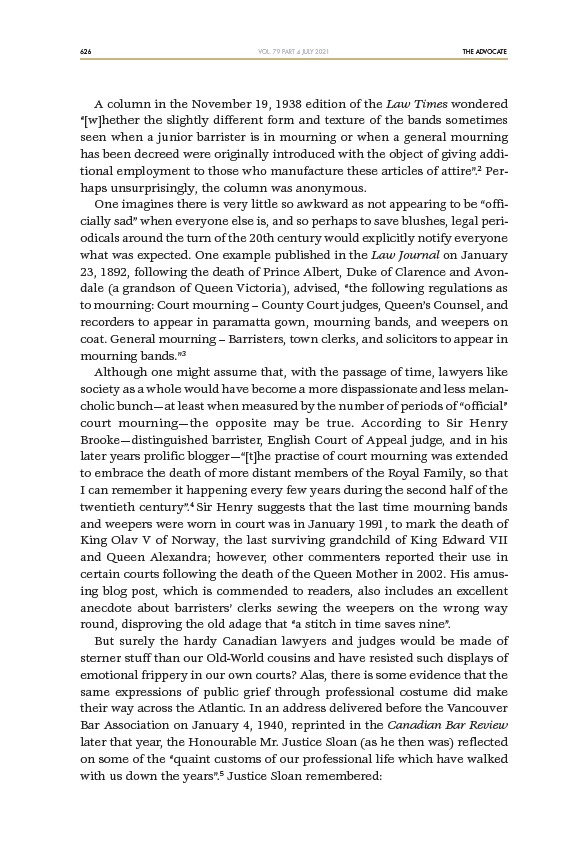
626 THE ADVOCATE
VOL. 79 PART 4 JULY 2021
A column in the November 19, 1938 edition of the Law Times wondered
“whether the slightly different form and texture of the bands sometimes
seen when a junior barrister is in mourning or when a general mourning
has been decreed were originally introduced with the object of giving additional
employment to those who manufacture these articles of attire”.2 Perhaps
unsurprisingly, the column was anonymous.
One imagines there is very little so awkward as not appearing to be “officially
sad” when everyone else is, and so perhaps to save blushes, legal periodicals
around the turn of the 20th century would explicitly notify everyone
what was expected. One example published in the Law Journal on January
23, 1892, following the death of Prince Albert, Duke of Clarence and Avondale
(a grandson of Queen Victoria), advised, “the following regulations as
to mourning: Court mourning – County Court judges, Queen’s Counsel, and
recorders to appear in paramatta gown, mourning bands, and weepers on
coat. General mourning – Barristers, town clerks, and solicitors to appear in
mourning bands.”3
Although one might assume that, with the passage of time, lawyers like
society as a whole would have become a more dispassionate and less melancholic
bunch—at least when measured by the number of periods of “official”
court mourning—the opposite may be true. According to Sir Henry
Brooke—distinguished barrister, English Court of Appeal judge, and in his
later years prolific blogger—“the practise of court mourning was extended
to embrace the death of more distant members of the Royal Family, so that
I can remember it happening every few years during the second half of the
twentieth century”.4 Sir Henry suggests that the last time mourning bands
and weepers were worn in court was in January 1991, to mark the death of
King Olav V of Norway, the last surviving grandchild of King Edward VII
and Queen Alexandra; however, other commenters reported their use in
certain courts following the death of the Queen Mother in 2002. His amusing
blog post, which is commended to readers, also includes an excellent
anecdote about barristers’ clerks sewing the weepers on the wrong way
round, disproving the old adage that “a stitch in time saves nine”.
But surely the hardy Canadian lawyers and judges would be made of
sterner stuff than our Old-World cousins and have resisted such displays of
emotional frippery in our own courts? Alas, there is some evidence that the
same expressions of public grief through professional costume did make
their way across the Atlantic. In an address delivered before the Vancouver
Bar Association on January 4, 1940, reprinted in the Canadian Bar Review
later that year, the Honourable Mr. Justice Sloan (as he then was) reflected
on some of the “quaint customs of our professional life which have walked
with us down the years”.5 Justice Sloan remembered: